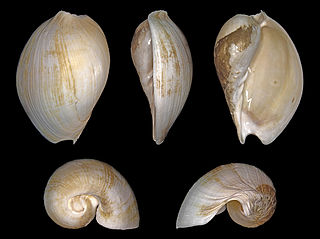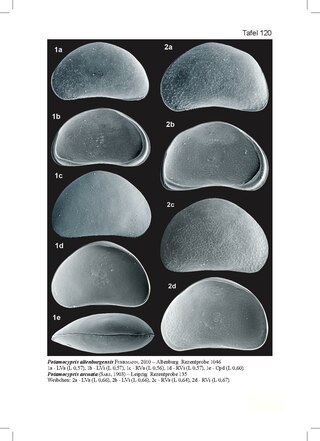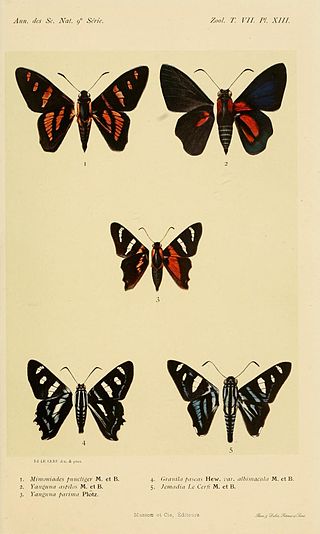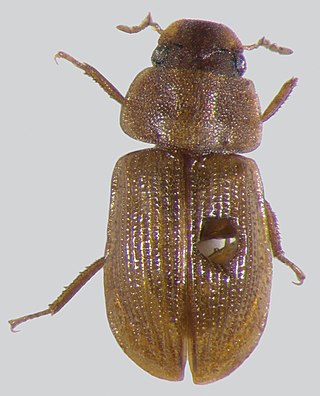
Ostracods, or ostracodes, are a class of the Crustacea, sometimes known as seed shrimp. Some 33,000 species have been identified, grouped into 7 valid orders. They are small crustaceans, typically around 1 mm (0.04 in) in size, but varying from 0.2 to 30 mm in the case of the marine Gigantocypris. The largest known freshwater species is Megalocypris princeps, which reach 8mm in length. In most cases, their bodies are flattened from side to side and protected by a bivalve-like valve or "shell" made of chitin, and often calcium carbonate. The family Entocytheridae and many planktonic forms do not have calcium carbonate. The hinge of the two valves is in the upper (dorsal) region of the body. Ostracods are grouped together based on shell and soft part morphology. While early work indicated the group may not be monophyletic and early molecular phylogeny was ambiguous on this front, recent combined analyses of molecular and morphological data suggested monophyly in analyses with broadest taxon sampling, but this monophyly had no or very little support. They have a wide range of diets, and the class includes carnivores, herbivores, scavengers and filter feeders, but most ostracods are deposit feeders.
Palaeocursornis is a monotypic genus of pterosaurs. The only known species, P. corneti, was described in 1984 based on a single bone interpreted as the distal part of a left femur, found in Early Cretaceous (Berriasian rocks from a mine at Cornet near Oradea in northwestern Romania. It was initially assumed to be a flightless paleognathe bird, possibly a ratite, and later as a more primitive ornithuromorph or non-avialan theropod. However, re-evaluation of the specimen suggested that it was not a femur at all, but the upper arm bone of a pterodactyloid pterosaur similar to Azhdarcho.

Louis Édouard Bureau was a French physician and botanist.
Acastellina is a genus of minute trilobites in the order Phacopida, which existed in what is now Germany. It was described by Richter and Richter in 1954. The type species is Acastellina nolens, originally described as a species of Acastella.

Léopold Reichling was a Luxembourg biologist and naturalist.

Paramysis is a genus of mysid crustaceans (Mysidacea) in family Mysidae, distributed in coastal zone of low boreal East Atlantic Ocean, Mediterranean Sea and the basins of Black Sea, Sea of Azov and Caspian Sea.

Gigantocypris, sometimes known as giant ostracod or giant seed shrimp, is a genus of ostracod crustaceans in family Cypridinidae, and among the most well-known members of the class Ostracoda. Its members are extremely large for ostracods, measuring up to 3.2 cm (1.3 in) across, have a globular shape, are typically semi-transparent orange or reddish, and have a large pair of mirror-like eyes that are used to locate their small animal prey. They are found worldwide in dark, deep and cold oceans.

Theodore Wells Pietsch III is an American systematist and evolutionary biologist especially known for his studies of anglerfishes. Pietsch has described 72 species and 14 genera of fishes and published numerous scientific papers focusing on the relationships, evolutionary history, and functional morphology of teleosts, particularly deep-sea taxa. For this body of work, Pietsch was awarded the Robert H. Gibbs Jr. Memorial Award in Systematic Ichthyology by the American Society of Ichthyologists and Herpetologists in 2005. Pietsch has spent most of his career at the University of Washington in Seattle as a professor mentoring graduate students, teaching ichthyology to undergraduates, and curating the ichthyology collections of the UW Burke Museum of Natural History and Culture.

Cymbium tritonis is a species of sea snail, a marine gastropod mollusk in the family Volutidae, the volutes.

Oocorys sulcata is a species of large sea snail, a marine gastropod mollusk in the family Cassidae, the helmet snails and bonnet snails.

Pentachlaena is a genus of flowering plant belonging to the Sarcolaenaceae family, endemic to Madagascar. It was first scientifically described in 1920.
Potamocypris is a genus of ostracod crustaceans in the family Cyprididae. There are currently 44 extant species of Potamocypris. The majority of the species occur in freshwater habitats; only a few species of the genus colonize marine brackish coastal waters.

Potamocypris mastigophora is a species of ostracod crustacean in the family Cyprididae, subfamily Cypridopsinae. It is known from Africa and the southern areas of the Palaearctic.
Potamocypris steueri is a species of ostracod crustaceans in the family Cyprididae, subfamily Cypridopsinae found in marine brackish waters of the Mediterranean Basin as well as in brackish coastal waters of the Black Sea and the Caspian Sea.
Potamocypris variegata is a species of ostracod crustaceans in the family Cyprididae, subfamily Cypridopsinae. It is mainly found in ponds with rich aquatic vegetation, more rarely in slowly flowing streams. The species is distributed throughout Europe, but is also known from North America.
Potamocypris unicaudata is a species of ostracod crustacean in the family Cyprididae, subfamily Cypridopsinae. It is abundantly found in ditches and ponds near the sea shore, where freshwater slightly mingles with sea water. It is known from both Europe and North America.

Potamocypris arcuata is a species of ostracod crustacean in the family Cyprididae, subfamily Cypridopsinae. It is mainly known from the southern areas of the Palaearctic.

Ocypode fabricii is a species of ghost crabs endemic to the coast of northern and western Australia, from Darwin to Shark Bay. They are medium-sized ghost crabs with a squarish body. The carapace reaches a length of 38 mm (1.5 in) and a width of 40 mm (1.6 in). Like other ghost crabs, one of their claws is much larger than the other. They live in burrows in the intertidal zones of the muddy to sandy beaches of mangrove forests.

Eugène Anatole Auguste Victor Boullet was a French naturalist, entomologist and collector.

Acidocerus aphodioides is a species of water scavenger beetle in the family Hydrophilidae. It is the only species in the genus Acidocerus. It is known only from Mozambique.













